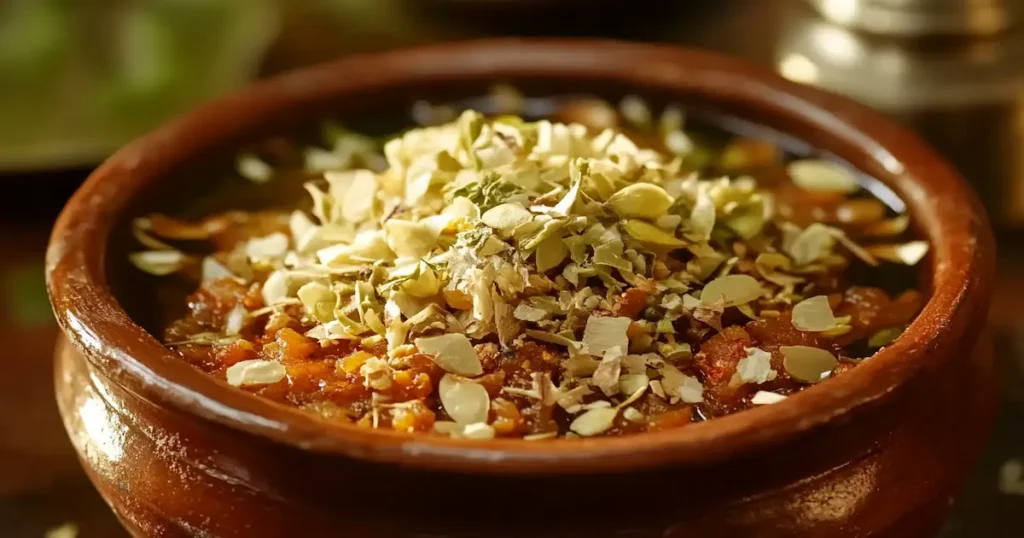Ugadi, also known as Telugu New Year, marks the beginning of a new year for people in the Indian states of Andhra Pradesh, Telangana, and Karnataka. It is a festival that celebrates life, nature’s seasonal cycles, and the triumph of good over evil. One of the most cherished traditions of Ugadi is the preparation of Ugadi Pachadi, a dish that symbolizes the complexity and the varying emotions of life. The dish is a concoction of six different ingredients, each symbolizing a different aspect of life. In this comprehensive guide, we’ll explore everything about Ugadi Pachadi—from the recipe itself to its significance, history, variations, and tips for preparing the dish.
Understanding the Significance of Ugadi Pachadi
Before diving into the recipe, it’s essential to understand the cultural importance of Ugadi Pachadi.
What is Ugadi Pachadi?
Ugadi Pachadi is a dish made with a combination of jaggery (sweet), raw mango (sour), neem flowers (bitter), tamarind (sour), green chilies (spicy), and salt (salty). These six flavors are meant to symbolize the different emotions humans experience in life:
- Sweetness (Jaggery): Represents happiness and joy.
- Sourness (Raw Mango and Tamarind): Symbolizes challenges and difficulties.
- Bitterness (Neem Flowers): Signifies hardships and sorrow.
- Saltiness: Represents the basic nature of life, that it’s neither too sweet nor too sour.
- Spiciness (Green Chilies): Depicts the sharp, unexpected turns in life.
Together, these flavors represent the unpredictable nature of life, where happiness and sorrow coexist, and every experience is a part of the larger journey. Ugadi Pachadi serves as a reminder that life is a balance of different experiences, and we should embrace all of them.
The Cultural and Religious Significance of Ugadi Pachadi
Ugadi is celebrated with much fervor in the Indian states of Andhra Pradesh, Telangana, and Karnataka. The day marks the beginning of the new lunar year in these regions, and it is considered an auspicious time for new beginnings. On Ugadi, people visit temples, perform pujas (prayers), decorate their homes with mango leaves, and prepare a variety of traditional dishes. Among all the dishes, Ugadi Pachadi holds a special place in the hearts of the people as it symbolizes the start of a new cycle, filled with mixed emotions and experiences.

Ingredients Needed for Ugadi Pachadi
The ingredients for Ugadi Pachadi are simple yet powerful in their symbolism. Here’s a list of everything you will need to prepare this dish:
Primary Ingredients:
- Raw Mango (1/4 cup, chopped into small pieces): Adds a sour and tangy flavor to the dish.
- Jaggery (1/4 cup, grated): This natural sweetener balances out the sourness and bitterness.
- Tamarind (1 tbsp, soaked in water): Tamarind provides an additional sour note to the dish.
- Neem Flowers (1 tsp, fresh or dried): The bitterness of neem flowers symbolizes hardship and sorrow.
- Green Chilies (1-2, slit): The spice from the chilies adds an element of surprise and represents the sharp turns of life.
- Salt: To enhance the flavors and add the salty aspect to the mix.
- Water (1/2 cup): To adjust the consistency of the dish.
For Tempering (Tadka or Seasoning):
- Cumin Seeds (1/2 tsp): Adds an earthy flavor to the dish.
- Mustard Seeds (1/2 tsp): Mustard seeds are essential for the tempering.
- Hing (Asafoetida) (1/4 tsp): Adds a subtle flavor and aroma.
- Oil (1 tsp): Used for tempering the spices.
For Garnishing:
- Coriander Leaves: Chopped, to garnish and add a fresh flavor to the pachadi.
Step-by-Step Instructions to Make Ugadi Pachadi
Step 1: Prepare Tamarind Extract
Begin by soaking the tamarind in warm water for about 10 minutes. After it softens, extract the juice by squeezing the tamarind pulp. Set the tamarind extract aside for later use in the dish.
Step 2: Prepare the Raw Mango and Jaggery Mixture
In a mixing bowl, combine the chopped raw mango with grated jaggery. Mix well until the jaggery begins to dissolve slightly. Raw mango provides the sourness, while jaggery balances it with sweetness. This combination of sweet and sour flavors is a perfect base for the dish.
Step 3: Prepare the Tempering (Tadka)
In a small pan, heat the oil over medium heat. Once the oil is hot, add mustard seeds and cumin seeds. Allow the seeds to splutter. Then, add the slit green chilies and hing. Stir the tempering for about 1 minute, allowing the spices to release their aroma.
Step 4: Add Tamarind Extract and Neem Flowers
Once the tempering is done, add the tamarind extract to the pan. Stir in the neem flowers, which will impart a slight bitterness to the pachadi. Neem flowers represent the hardships of life but are essential for maintaining balance. Let this mixture simmer for 5 minutes, allowing the flavors to meld together.
Step 5: Combine Everything
Now, add the jaggery and raw mango mixture to the pan. Mix well, and cook for an additional 5-10 minutes, letting the dish simmer. The jaggery will melt, and the flavors from the raw mango, tamarind, and spices will blend together beautifully.
Step 6: Adjust Consistency
If the pachadi is too thick, add a little water to adjust the consistency. You want the pachadi to be a bit thick but not too dry. Stir well to ensure everything is combined and the dish has a smooth texture.
Step 7: Final Touch – Garnish and Serve
Once done, remove the dish from heat and garnish with freshly chopped coriander leaves. This adds a fresh, herby note to the pachadi, balancing out the intensity of the other flavors. Now, your Ugadi Pachadi is ready to be served!

Variations of Ugadi Pachadi
While the basic recipe remains the same, different regions and families may have slight variations in how they prepare Ugadi Pachadi. Here are a few variations:
1. Ugadi Pachadi with Coconut
Some variations of Ugadi Pachadi include grated coconut. The coconut adds a creamy texture and a mildly sweet flavor, which complements the bitterness of the neem flowers. You can simply add freshly grated coconut after mixing the raw mango and jaggery.
2. Ugadi Pachadi with Pomegranate Seeds
Pomegranate seeds can be added to the pachadi for an additional burst of sweetness and color. The seeds provide a juicy texture that contrasts nicely with the sour and bitter elements of the dish.
3. Ugadi Pachadi with Peanuts
Some people add roasted peanuts to the pachadi for crunch and an earthy flavor. The peanuts enhance the overall texture and add protein to the dish.
4. Ugadi Pachadi with Sesame Seeds
Sesame seeds are another ingredient that can be added for extra crunch. These seeds add a nutty flavor, which complements the sweet, sour, and bitter notes of the pachadi.
Serving Ugadi Pachadi
Ugadi Pachadi is typically served at the start of the Ugadi meal. It is part of a larger feast that includes a variety of dishes, such as:
- Pulihora (Tamarind Rice): A tangy rice dish made with tamarind and spices.
- Bobbatlu (Sweet Flatbread): A sweet, stuffed flatbread made with a mixture of chana dal (split chickpeas) and jaggery.
- Coconut Rice: A mild, fragrant rice dish with grated coconut.
Ugadi Pachadi is meant to be eaten in small amounts at the beginning of the meal, and it’s usually shared with family members as a symbol of goodwill for the upcoming year.
Health Benefits of Ugadi Pachadi Ingredients
While Ugadi Pachadi is a delicious dish, it also offers several health benefits due to its diverse ingredients:
- Neem Flowers: Neem is known for its detoxifying properties. It is an excellent herb for purifying the blood and promoting overall health.
- Raw Mango: Rich in vitamin C and antioxidants, raw mango helps boost immunity and aids digestion.
- Jaggery: A natural sweetener, jaggery is less processed than sugar and contains essential minerals like iron, magnesium, and potassium.
- Tamarind: Tamarind is known to aid in digestion and is a good source of fiber, vitamins, and minerals.
Conclusion:
The Perfect Symbolism in Every Bite
Ugadi Pachadi is more than just a dish; it’s a representation of life’s intricate balance of emotions. Each ingredient plays a role in expressing the varied experiences we go through. Whether sweet or sour, bitter or spicy, Ugadi Pachadi encourages us to embrace life in all its diversity. Prepare this dish with love and devotion, and let it bring joy and fulfillment into your home during the Ugadi celebrations.
Frequently Asked Questions (FAQs)
1. Can I make Ugadi Pachadi without neem flowers? Yes, you can skip the neem flowers if they are unavailable. However, they do add a unique bitter flavor that is symbolic of life’s hardships.
2. Can I use sugar instead of jaggery? While jaggery is preferred for its natural sweetness and health benefits, you can use sugar as a substitute if necessary.
3. How long can I store Ugadi Pachadi? Ugadi Pachadi is best consumed fresh, but you can store it in an airtight container in the refrigerator for 1-2 days.
4. Can I make Ugadi Pachadi spicy? Yes, you can increase the number of green chilies to make the dish spicier, depending on your preference.
5. Can I use sweet mango instead of raw mango? Sweet mango is not typically used in Ugadi Pachadi, as the tangy flavor of raw mango is essential for its authenticity. However, you can try it if you prefer a sweeter taste.



